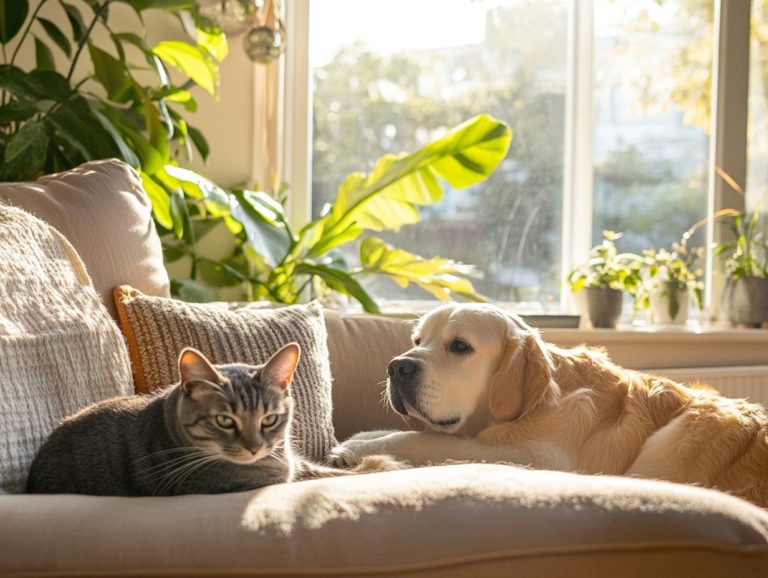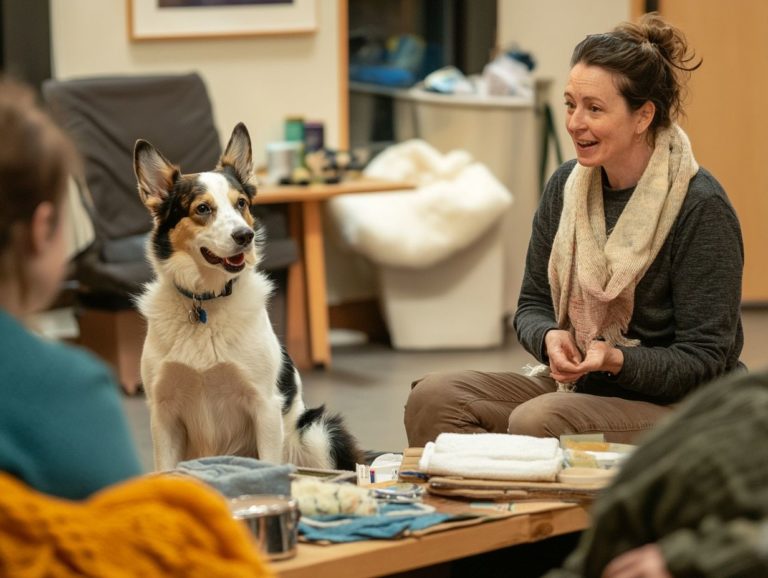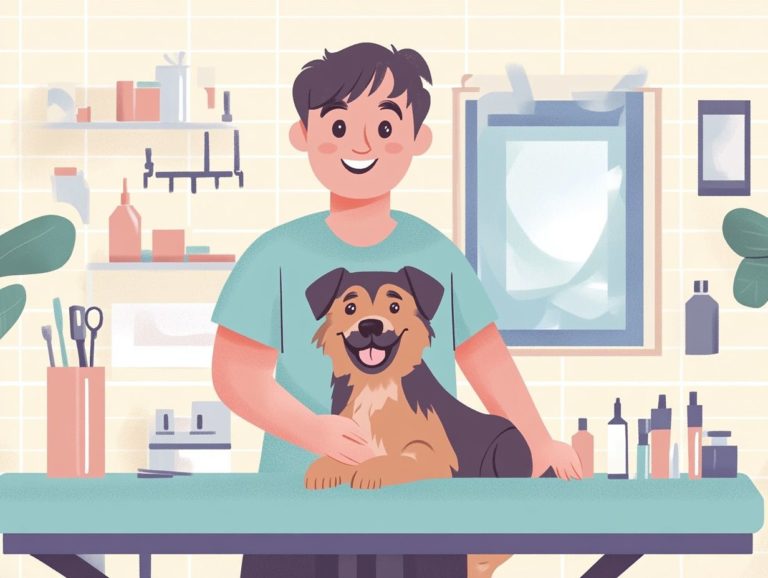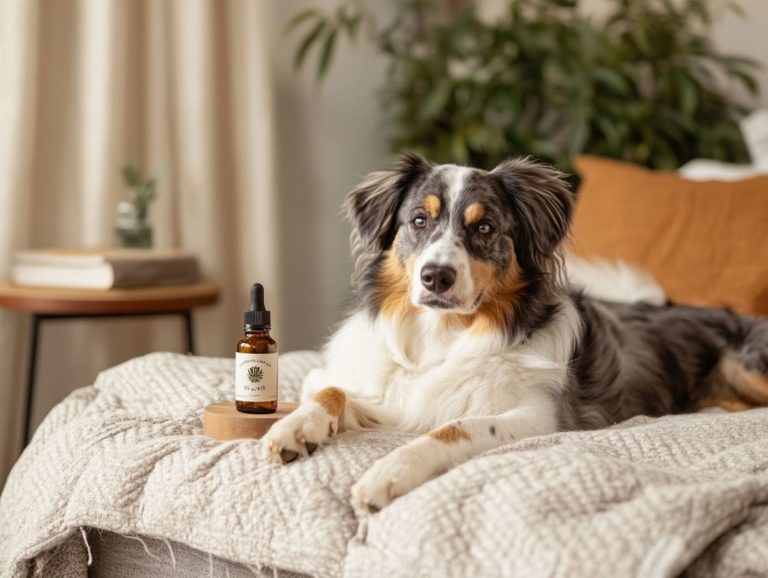How to Identify the Triggers of Your Pet’s Anxiety?
Pets, like humans, can experience anxiety. Understanding this emotional strain is essential for their well-being.
This article delves into the various causes of pet anxiety, the signs to be aware of, and common triggers that may impact your furry companion. You will also find practical techniques to help manage and alleviate anxiety, along with guidance on when it s time to seek professional help.
You will also find tips for creating a calm environment aimed at preventing anxiety from taking root.
Jump in now to discover how to boost your pet’s mental health!
Contents
- Key Takeaways:
- Understanding Pet Anxiety
- Signs and Symptoms of Pet Anxiety
- Identifying Triggers of Pet Anxiety
- Managing and Addressing Pet Anxiety
- Seeking Professional Help for Pet Anxiety
- Preventing Pet Anxiety
- Frequently Asked Questions
- What are some common triggers of pet anxiety?
- How can I tell if my pet is experiencing anxiety?
- Is it possible for my pet to develop anxiety later in life?
- Can certain breeds be more prone to anxiety?
- How can I identify the specific triggers of my pet’s anxiety?
- What steps can I take to help my pet manage their anxiety?
Key Takeaways:

- Recognize common triggers of pet anxiety, such as loud noises, changes in routine, and separation from owner.
- Observe your pet’s behavior for signs of anxiety, such as excessive barking, pacing, or destructive behavior.
- Create a calm and safe environment for your pet by providing routine, comfort, and positive reinforcement. Seek professional help if necessary.
Understanding Pet Anxiety
Understanding pet anxiety requires you to recognize the myriad factors contributing to anxiety in dogs, including specific anxiety traits inherited from their parents. It s crucial for you, as a pet owner, to be aware of these issues to ensure your dog receives the appropriate care and veterinary guidance they deserve.
Anxious dogs display a range of behaviors influenced by their specific triggers, stemming from environmental factors or even genetics. Common causes of dog anxiety include separation anxiety, fear during thunderstorms, and age-related anxiety.
What Causes Anxiety in Pets?
Anxiety in pets can stem from a variety of sources, including genetic influences, environmental triggers, and health-related concerns that may intensify a dog s anxiety disorder.
Some dogs may inherit anxiety traits from their parents. Specific health conditions, such as chronic pain or hormonal imbalances, can greatly amplify anxious tendencies. Environmental factors like loud noises, unfamiliar surroundings, or a lack of socialization often exacerbate stress levels.
According to the Merck Veterinary Manual, addressing these elements through appropriate training, regular health check-ups, and fostering a supportive environment can be crucial in alleviating anxiety for your beloved companions.
Signs and Symptoms of Pet Anxiety
Recognizing the signs of pet anxiety is essential for pet owners. These indicators can manifest in various ways, from subtle shifts in body language to pronounced displays of aggression. Understanding the influence of environment on pet anxiety can also help in addressing these behaviors effectively.
Being attuned to these nuances can make all the difference in providing the care and support your beloved pet needs.
Behaviors to Look Out For
When observing anxious dogs, there are specific behaviors you should be on the lookout for, such as signs of aggression, excessive barking, and other distress signals that can arise during training sessions or in unfamiliar settings.
For instance, you might notice a dog cowering or hiding in response to loud noises, or perhaps it s reluctant to engage in play, which can indicate unease. Physical symptoms can manifest as panting, pacing, or even trembling, all clearly pointing to discomfort.
To help alleviate these anxiety symptoms, you can employ positive reinforcement techniques during training, rewarding calm behavior with treats or praise. Establishing a consistent routine will provide a sense of stability for anxious dogs, helping them feel more secure in their surroundings. Utilizing calming aids like anxiety wraps or pheromone diffusers can create a soothing environment that fosters confidence.
Identifying Triggers of Pet Anxiety

Identifying the specific triggers of pet anxiety is crucial for developing effective strategies to help your anxious dog cope, as outlined in understanding pet anxiety.
Environmental stimuli, such as loud noises or unfamiliar surroundings, can induce fear-related anxiety. Recognizing signs your pet may be experiencing anxiety allows you to create a supportive environment tailored to your dog’s needs.
Common Triggers and How to Recognize Them
Common triggers of dog anxiety often stem from environmental factors like thunderstorms, bustling dog parks, and unfamiliar situations. Recognizing these can help you identify signs your pet needs help with anxiety.
You might notice significant changes in your dog s behavior during these scenarios, such as cowering, excessive barking, or seeking a hiding spot. Each dog reacts differently, influenced by their temperament and past experiences.
During a thunderstorm, your dog may seek shelter under furniture or cling to your side, clearly signaling fear. In crowded environments like a busy dog park, signs of stress may include growling or attempts to escape.
Identifying these signals is essential. Once you do, you can implement effective strategies, like recognizing anxiety in older pets or using calming products, to soothe your furry friend’s anxiety.
Managing and Addressing Pet Anxiety
Managing your pet’s anxiety requires a comprehensive treatment plan that blends dog training, changing how your dog reacts to stress, and if necessary, anxiety medications or natural remedies like CBD oil.
This thoughtful approach aims to alleviate symptoms in anxious dogs, ensuring they feel more at ease in their environment.
Simple Ways to Calm Your Dog s Nerves!
Techniques for reducing anxiety in dogs include:
- Changing how your dog reacts to stress
- Positive reinforcement
- Behavior modification
These methods create a supportive framework, helping your dog associate frightening stimuli with positive experiences. For instance, gradually exposing your dog to anxiety-inducing situations while offering rewards fosters a sense of safety.
Using positive reinforcement strategies, such as giving treats or praise for calm behavior, encourages your dog to repeat those desired actions, boosting their confidence.
Behavior modification focuses on changing your dog s behavior over time. This might involve techniques like desensitization and establishing a predictable routine to stabilize their emotional state.
By utilizing these techniques, you can significantly improve your dog s quality of life.
Seeking Professional Help for Pet Anxiety
Getting help from a professional can make a big difference for you and your dog! Veterinarians and animal behaviorists offer personalized strategies that target specific anxiety issues, including conditions like cognitive dysfunction syndrome in older dogs.
This support can lead to a more harmonious relationship, ultimately enhancing the well-being of your beloved pet.
When to Consult a Veterinarian or Behaviorist
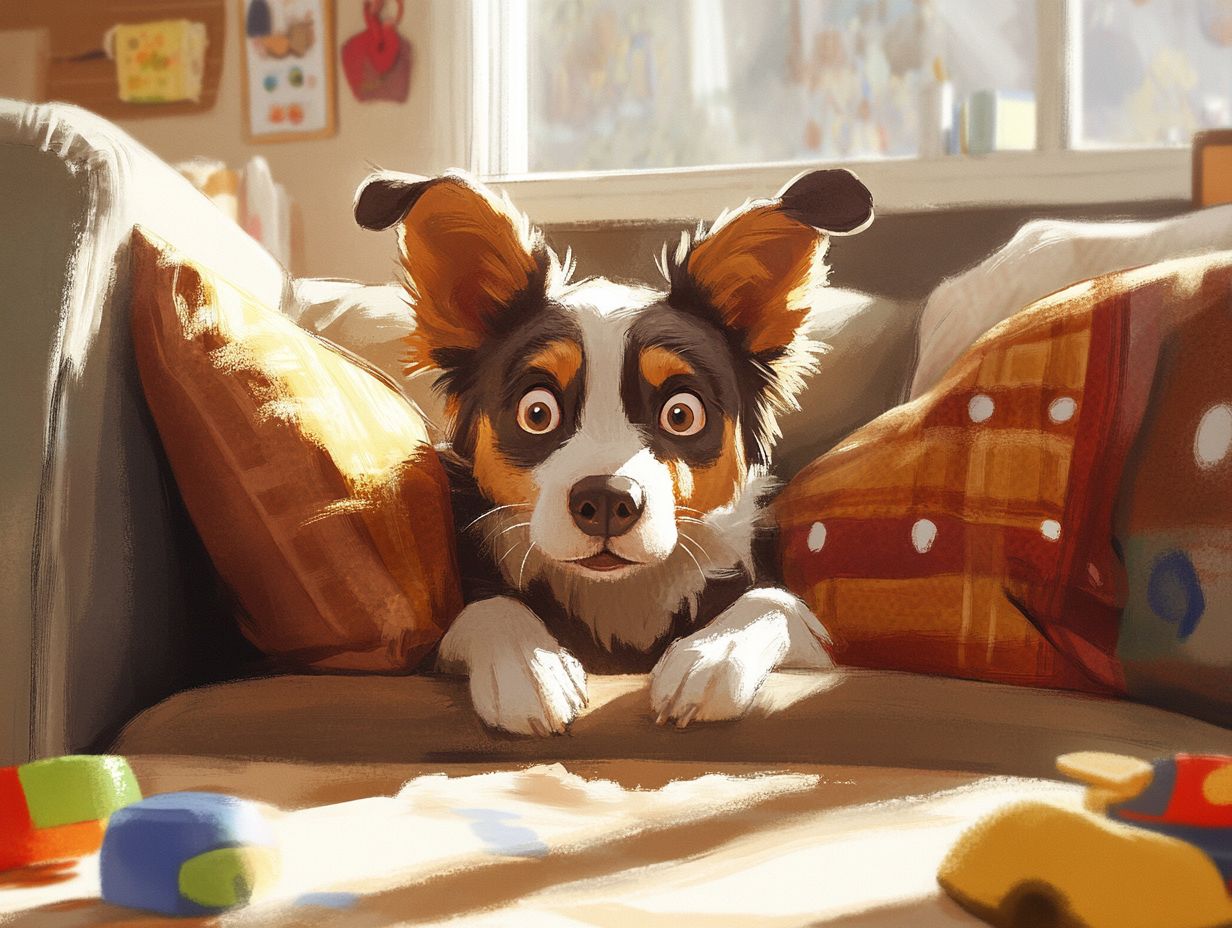
Knowing when to consult a veterinarian or a behaviorist is essential for effectively managing your pet’s anxiety. This is especially important when signs of a condition that affects your pet s thinking ability emerge alongside more typical anxiety symptoms.
Spotting these signs early can dramatically improve your pet’s life! You can significantly enhance your pet s quality of life and stave off further decline in their mental health. Stay alert for behaviors like excessive vocalization, destructive chewing, or changes in eating habits. These may signal a more serious underlying issue.
Seek professional help as soon as you notice signs. Experts can implement tailored strategies ranging from behavioral therapies to medication that can help ease your pet’s distress. By grasping the nuances of these signs and the benefits of early intervention, you can create a healthier, happier environment for your beloved companion.
Preventing Pet Anxiety
Preventing pet anxiety requires you to take proactive steps. Establish a serene and secure environment that caters to the unique needs of various dog breeds. By doing so, you can significantly alleviate anxiety symptoms and promote their emotional well-being.
Tips for Creating a Calm and Safe Environment for Your Pet
Creating a calm and safe environment for your pet starts with identifying and addressing environmental triggers. To further support their well-being, consider understanding the needs of anxious pets and applying positive reinforcement techniques that promote both their canine health and psychological well-being.
Begin by evaluating your home for areas that may induce anxiety, such as loud noises or chaotic spaces. Simple adjustments, like setting up a cozy retreat with familiar blankets and toys, can make a significant difference.
Establishing a consistent daily routine is equally important. Regular feeding, exercise, and playtime provide the stability and predictability that help your dog feel secure.
Incorporating soothing sounds or calming scents can further enhance the atmosphere. This fosters a more relaxed state for your furry friend. Each of these thoughtful steps nurtures their emotional needs, ensuring a happier and healthier canine companion.
Frequently Asked Questions
What are some common triggers of pet anxiety?
Some common causes of pet anxiety include loud noises, changes in routine, separation from their owner, unfamiliar environments, and past traumatic experiences. To better understand these issues, refer to this guide on how to recognize and address anxiety in pets. These triggers can lead to various types of anxiety disorders, including separation anxiety and fear-related anxiety.
How can I tell if my pet is experiencing anxiety?
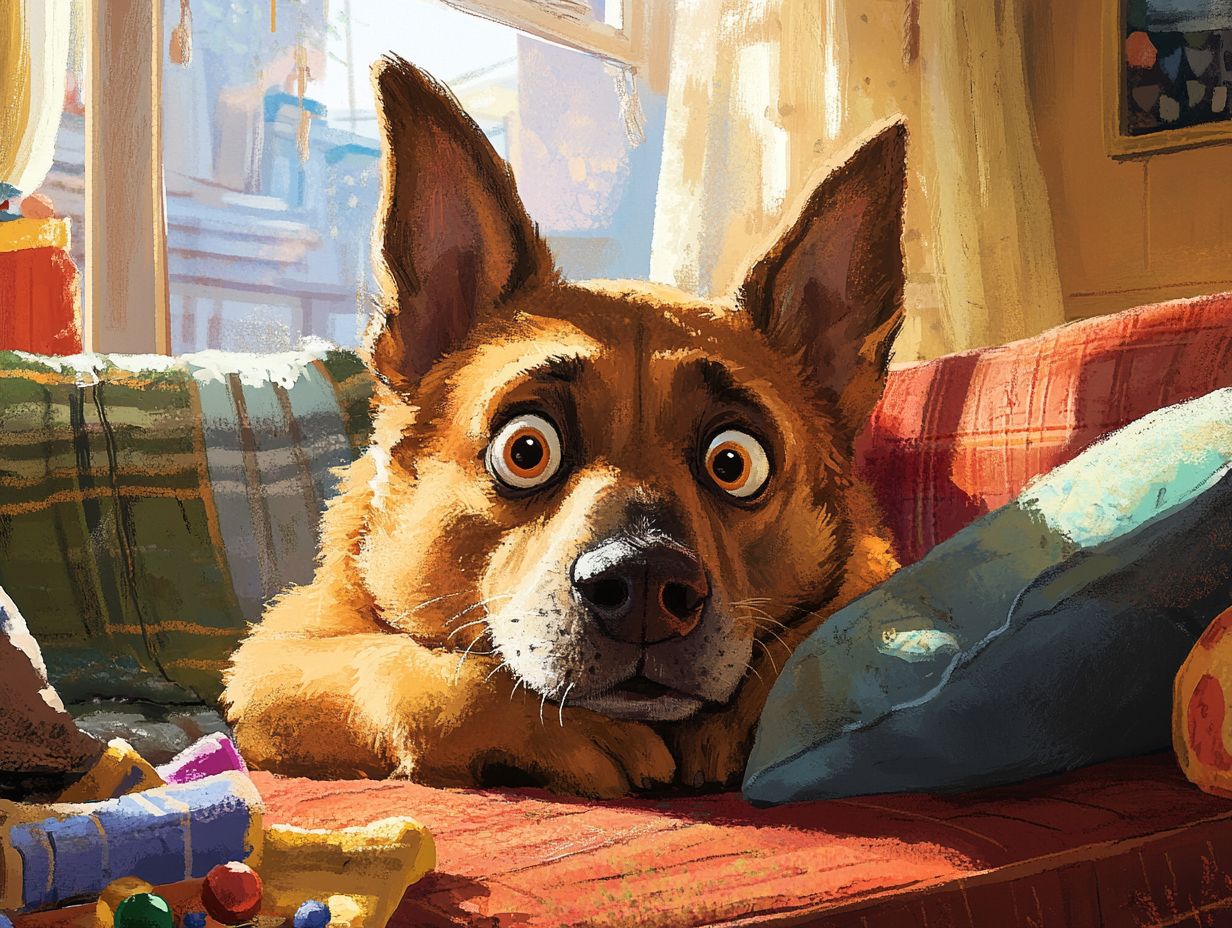
Signs of pet anxiety may include excessive barking or meowing, destructive behavior, hiding, trembling, panting, or restlessness. Understanding these signs is crucial, as each pet may exhibit different behaviors. Learning the benefits of understanding your pet’s anxiety can help you pay attention to any changes in your pet’s behavior.
Is it possible for my pet to develop anxiety later in life?
Yes, just like humans, pets can develop anxiety at any point in their life. This can be caused by changes in their environment, health issues, or even aging.
Can certain breeds be more prone to anxiety?
Yes, some breeds are known to be more susceptible to anxiety, such as Border Collies, German Shepherds, and Labrador Retrievers. However, every individual pet is unique and may react differently to triggers.
How can I identify the specific triggers of my pet’s anxiety?
The best way to identify the triggers of your pet’s anxiety is to observe their behavior and routines. Keeping a diary or taking notes of any changes in behavior can help you understand anxiety triggers in pets and identify patterns. Consulting with a veterinarian or animal behaviorist can also help pinpoint triggers.
Don’t wait! Consult a vet today if your pet shows any signs of anxiety.
What steps can I take to help my pet manage their anxiety?
There are various methods to help manage anxiety in pets. These include providing a safe and comfortable environment.
Use calming aids like pheromone diffusers or supplements. Regular exercise and mental stimulation are key.
Talk to your vet for personalized advice. Start making these changes today for a happier, calmer pet!

